- You are here:
- Home »
- Oven Recipes
- » The Perfect Halibut Fillets Oven Recipe
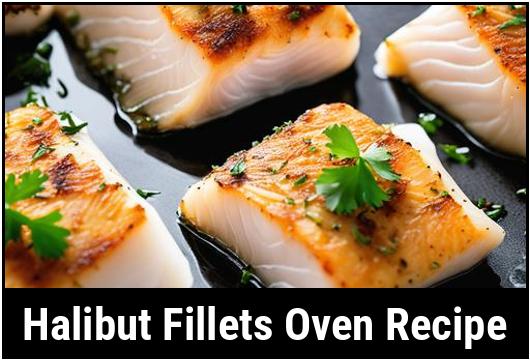
The Perfect Halibut Fillets Oven Recipe
When it comes to creating a tantalizing seafood dish that is both healthy and delicious, halibut fillets are a fantastic choice. With their firm yet delicate texture and mild, sweet flavor, halibut fillets have won the hearts of seafood enthusiasts everywhere. While there are numerous ways to prepare this delectable fish, today we will focus on an oven-baked recipe that is sure to impress even the most discerning palates. In this comprehensive guide, we’ll delve into the food science behind halibut fillets, provide culinary details, highlight selection and cleaning tips, offer precise preparation instructions, share variations for personalization, explain doneness checks, and even discuss the consequences of overcooking or undercooking this delightful dish. Get ready to embark on a culinary adventure with this ultimate halibut fillets oven recipe!
Section 1: Food Science of Halibut Fillets
Before we dive into the recipe itself, it’s essential to understand the key food science behind halibut fillets. This knowledge will help us make informed choices throughout the cooking process and ensure that our final dish is cooked to perfection.
1.1 Understanding Halibut Fillets
Halibut fillets come from the flatfish species known as halibut. With its flat, diamond-shaped body, this cold-water fish offers tender white flesh that is both lean and flaky. The texture of halibut fillets is crucial as it determines the cooking techniques best suited for them. These fillets are delicate yet firm, allowing them to withstand various cooking methods without breaking apart.
1.2 The Nutritional Benefits
Halibut fillets are not only delicious but also an excellent source of nutrients. They are packed with high-quality proteins, omega-3 fatty acids, vitamins B12 and D, and essential minerals such as selenium and magnesium. Including halibut fillets in your diet can contribute to heart health, brain function, and overall well-being.
Section 2: Culinary Details
Now that we have a solid understanding of the science behind halibut fillets, let’s explore the culinary aspects that go into creating a memorable oven-baked dish.
2.1 Selecting Fresh Halibut Fillets
When it comes to selecting halibut fillets, freshness is paramount. Look for fillets with a subtle ocean scent, firm flesh, and no discoloration. The flesh should be moist and glistening, indicating its freshness. Ideally, purchase halibut fillets the same day you plan to cook them to ensure optimal quality and taste.
2.2 Cleaning and Prepping the Fillets
Before you begin cooking, it’s essential to clean and prep your halibut fillets properly. Start by rinsing the fillets under cold water to remove any excess scales or debris. Pat them dry with a paper towel, ensuring they are fully dry before moving on to the next step. Trimming any excess skin or fat can help promote even cooking and prevent unnecessary chewiness.
2.3 Marinating for Flavor Enhancement
While halibut fillets have an exquisite flavor on their own, marinating them can take that flavor profile to new heights. A simple marinade consisting of olive oil, lemon juice, garlic, and herbs like parsley or dill can infuse the fillets with aromatic and tangy notes. Allow the fillets to marinate for at least 30 minutes, or even overnight, to maximize the flavor infusion.
Section 3: Tips and Tricks
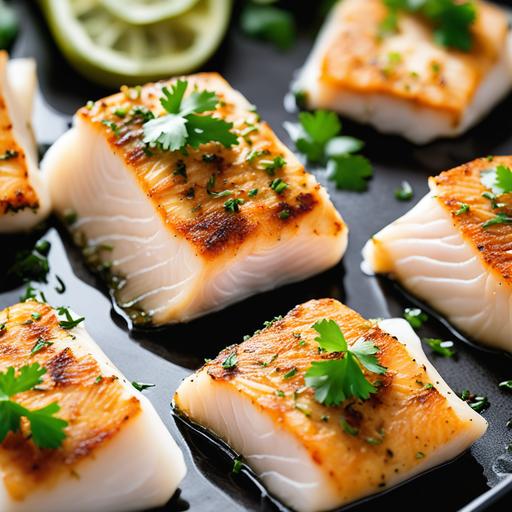
Preparing halibut fillets in the oven requires attention to detail and a few tricks up your sleeve. Here are some tips and tricks to ensure your oven-baked halibut fillets turn out perfectly every single time.
3.1 Choosing the Right Oven Temperature
The oven temperature plays a vital role in achieving the ideal texture and doneness for halibut fillets. Preheat your oven to 400°F (200°C) for a balance between a crispy outer layer and moist, tender flesh. Heating the oven to this temperature creates a beautiful golden crust while retaining the delicate nature of the fish.
3.2 Selecting the Perfect Baking Dish
To prevent your fillets from sticking to the baking dish and falling apart during cooking, choose a non-stick or well-seasoned baking dish. Alternatively, you can line the dish with parchment paper or aluminum foil to ensure easy removal after baking. The baking dish should be large enough to accommodate all the fillets without crowding, allowing for even heat distribution.
3.3 Understanding Cooking Time
The cooking time will depend on the thickness of your halibut fillets. As a general rule, plan to cook the fillets for approximately 10 minutes per inch of thickness. To ensure accuracy, use a timer or kitchen thermometer to check the internal temperature of the fillets. Halibut fillets are perfectly cooked when their internal temperature reaches 145°F (63°C), resulting in a flaky yet moist texture.
Section 4: The Scrumptious Oven-Baked Halibut Fillets Recipe
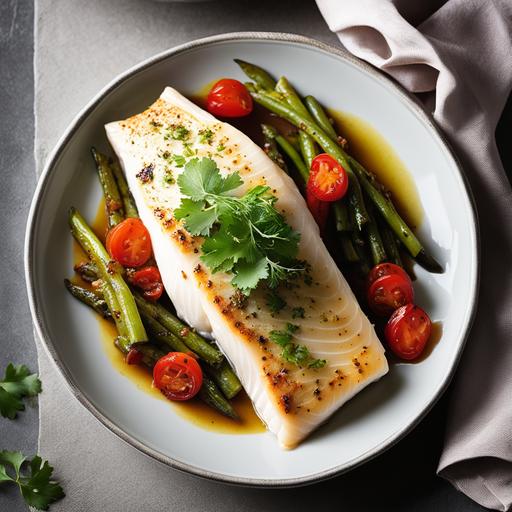
Now that we have covered the essential elements, it’s time to put it all together and unveil the ultimate oven-baked halibut fillets recipe. Brace yourself for a burst of flavors and culinary delight!
4.1 Ingredients:
-
4 fresh halibut fillets (6-8 ounces each), bones and skin removed
-
2 tablespoons of olive oil
-
Juice from 1 lemon
-
2 cloves of garlic, minced
-
1 teaspoon of dried parsley
-
Salt and pepper to taste
4.2 Instructions:
-
Preheat the oven to 400°F (200°C) and line a baking dish with parchment paper or aluminum foil if desired.
-
In a small bowl, whisk together the olive oil, lemon juice, minced garlic, dried parsley, salt, and pepper to prepare the marinade.
-
Place the halibut fillets in a shallow dish and pour the marinade over them. Ensure the fillets are evenly coated with the marinade. Let them marinate for at least 30 minutes in the refrigerator.
-
Once marinated, remove the halibut fillets from the dish and place them on the lined baking dish, making sure they are not overcrowded.
-
Bake the fillets in the preheated oven for approximately 10-12 minutes, or until the internal temperature reaches 145°F (63°C) using a kitchen thermometer.
-
Once cooked, remove the halibut fillets from the oven, and let them rest for a couple of minutes before serving.
4.3 Serving Suggestions:
Oven-baked halibut fillets pair beautifully with a variety of side dishes. Serve them with garlic butter roasted vegetables, steamed asparagus, or a refreshing green salad dressed with lemon vinaigrette. Complete the meal with a side of roasted potatoes or couscous for a hearty and satisfying experience.
Section 5: Variations for Personalization
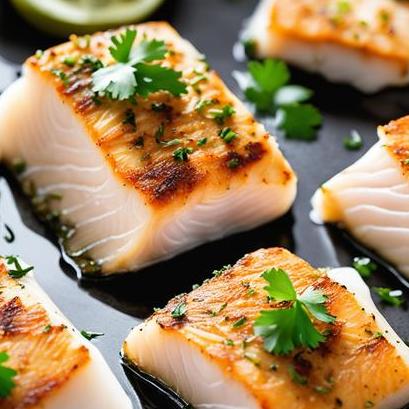
While the above recipe is absolutely delightful, feel free to add your own personal touch and experiment with different flavors to create a dish that suits your palate perfectly. Here are a few suggestions for variations:
-
Substitute the dried parsley with fresh herbs like cilantro or thyme for a vibrant burst of flavor.
-
Enhance the marinade by incorporating additional ingredients such as soy sauce, ginger, or chili flakes for an Asian-inspired twist.
-
Add a layer of thinly sliced lemons or oranges on top of the fillets before baking to infuse the fish with a citrusy tang.
Section 6: Ensuring the Perfect Doneness
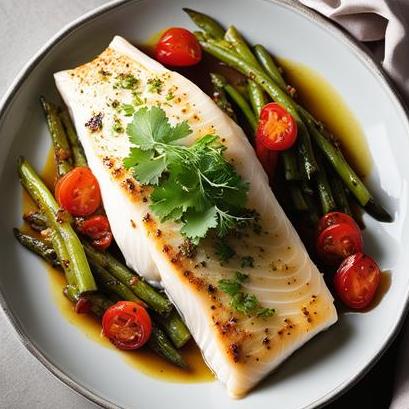
Achieving the perfect doneness is crucial to maximizing the enjoyment of your halibut fillets. Overcooking or undercooking can result in a disappointing culinary experience. Here are some essential tips to help you ensure the ideal doneness:
6.1 Signs of Overcooking
Overcooked halibut fillets tend to become dry, tough, and lack their signature flakiness. Watch out for these signs of overcooking:
-
The fish appears dry and begins to separate into hard flakes when touched with a fork.
-
The fillets lose their translucency and turn opaque throughout.
-
They have lost their natural sweetness and become bland or rubbery.
6.2 Signs of Undercooking
Undercooked halibut fillets might still possess a translucent, raw appearance and a softer texture. To avoid serving undercooked fish, look for these indicators:
-
The fillets still appear wet or shiny on the inside rather than opaque.
-
They feel relatively soft when gently pressed with a fork.
-
The fish lacks the desired flakiness and tends to fall apart easily.
Section 7: The Consequences of Overcooking or Undercooking
While we strive for perfection, occasionally, mishaps can occur. Understanding the consequences of overcooking or undercooking your halibut fillets will help navigate the cooking process more effectively.
7.1 Overcooking Effects
Overcooking halibut fillets can result in unpleasant consequences, such as:
-
The fish becomes dry, making it less palatable and enjoyable.
-
The texture becomes tough and chewy, severely diminishing the delicate nature of the fillets.
-
Overcooked halibut loses its natural flavors, resulting in a lackluster and disappointing eating experience.
7.2 Undercooking Effects
Undercooking halibut fillets also presents its own set of issues, including:
-
The fillets may taste raw, potentially leading to foodborne illnesses.
-
The texture is softer and lacks the desirable flaky consistency.
-
The flavors may not reach their full potential, resulting in a less satisfying meal.
Conclusion
Congratulations on embarking on this culinary journey to master the heavenly oven-baked halibut fillets recipe! Armed with a solid understanding of the food science, culinary details, selection, cleaning, preparation, tips, variations, doneness checks, and even the consequences of overcooking or undercooking, you are now equipped to create a dish that will captivate the taste buds of anyone who has the pleasure of trying it. Remember to utilize fresh, high-quality ingredients, and experiment with flavors to cater to your personal preferences. Enjoy your succulent and healthy halibut fillets, and savor every bite knowing that you have created a truly exceptional seafood dish.
Sources
FAQS On Halibut Fillets Oven Recipe
What Is The Best Way To Cook Halibut Fillets In The Oven?
Preheat the oven to 400°F and place the halibut fillets on a lightly greased baking sheet. Season the fillets with salt, pepper, and any desired herbs or spices. Bake for 12-15 minutes or until the fillets are opaque and flake easily with a fork.
How Should I Prepare The Halibut Fillets Before Cooking Them In The Oven?
Before cooking, pat the halibut fillets dry with paper towels to remove excess moisture. This will help the fillets brown evenly in the oven. You can also marinate the fillets in a mixture of olive oil, lemon juice, and garlic for added flavor.
What Is A Good Side Dish To Serve With Oven-baked Halibut Fillets?
Oven-roasted vegetables, such as asparagus, broccoli, or zucchini, make a delicious and healthy side dish to serve with halibut fillets. You can also serve the fish with a side of quinoa, couscous, or a fresh green salad for a complete meal.
How Do I Know When Halibut Fillets Are Fully Cooked In The Oven?
Halibut fillets are fully cooked when they are opaque and flake easily with a fork. The internal temperature of the fillets should reach 145°F to ensure that they are safe to eat. Be careful not to overcook the fillets, as they can become dry and tough.
Can I Add A Sauce Or Topping To The Halibut Fillets Before Baking Them In The Oven?
Yes, you can add a sauce or topping to the halibut fillets before baking them in the oven. Some popular options include a simple lemon and herb butter, a tangy mango salsa, or a creamy dill sauce. Simply spoon the sauce or topping over the fillets before baking and enjoy the delicious flavor combination.


